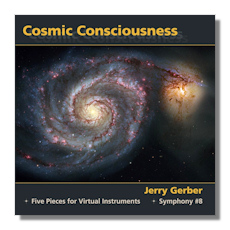
The Internet's Premier Classical Music Source
Related Links
- Gerber Reviews
- Latest Reviews
- More Reviews
-
By Composer
-
Collections
DVD & Blu-ray
Books
Concert Reviews
Articles/Interviews
Software
Audio
Search Amazon
Recommended Links
Site News
 CD Review
CD Review
Jerry Gerber

Cosmic Consciousness
- Symphony #8
- Five Pieces for Virtual Instruments
- Shadow Play
- Baroquette
- Luminous Night nebulous Light
- Seraphim on a Subway
- Shadow Work
Jerry Gerber, virtual instruments
Ottava Records 13-012
Gerber's Eighth Symphony begins quietly with a beautiful flowing melody and the ten- minute movement continues to give a sense of continuous flowing throughout, which gives this listener a sense of being taken on a journey – perhaps down a beautiful river. (I do not normally share any of my private reflections inspired by music, but in view of Gerber's provocative titles, this seems to be legitimate enough.) Brief solos are heard from each of the woodwinds in turn.
The shorter second movement – each of the four is simply called Part 1, Part 2, etc. – could have been called a scherzo. It introduces sounds from the brass – notably trumpet – and seems celebratory and playful, with more staccato effects, but continues to have momentum. The third part has a pastoral quality and includes a single soprano singing a vocalise, a male chorus singing without words that seem intelligible, and a gong, quiet at first but it sounds repeatedly, and louder, at the end of the movement.
The final part is highly varied in mood and treatment, from a rather modal section reminiscent of Vaughan Williams to a passage more like Morricone. It continues to carry one along with wherever Gerber is taking us on this half-hour journey, however. The work is generally lyrical, not dramatic, and exciting when it is less lyrical. It is always fresh-sounding.
Throughout my description of this symphony I have written as if this is a work for a normal symphony orchestra and chorus, because it can be heard that way. However, as has been the case with Gerber's works for many years – he has been writing music since 1982 – he has been presenting works for "virtual instruments." Actually, the instrumental sounds are more the products of real musical instruments than one might suspect, and they might perhaps more helpfully be called transformed instrumental sounds. Gerber makes extraordinarily skillful use of something called the "Vienna Instruments Symphonic Cube," and another electronically accessible package called "Requiem professional." As I understand these, hundreds varied instrumental sounds, attacks etc. (and real singing in a cathedral) were recorded for composers to take apart, combine and Much of the time a normal listener would be hard pressed to tell the difference from a more usual performance. But given the difficulty of getting a performance for any orchestral work – not to mention the expense – this is an excellent expedient. In any case, as I said, Gerber does this in an expert way.
Only in a few cases, as in Shadow Play, does this music sound at all like the product of an older generation electronic synthesizer. The Five Pieces are all under six minutes in duration, and this one less than four minute. Shadow Play has a fast percussion patter and a trumpet solo; it sounds like a Mideastern dance, at least at one point. Having just watched the 2014 Winter Olympics, I think that this little piece would appeal to ice dancers.
Baroquette is also fast and rhythmic, but its pace is too varied to confirm my suspicion that this is a little baroque piece, as the title would suggest. It has some long lines over a staccato accompaniment.
Luminous Night Nebulous Light (the cover of the CD has a Hubble picture of a spiral nebula) is quieter than the other pieces. Flute, strings and chorus are heard. Seraphim on a Subway offers beautiful soprano and choral singing to justify its title. Audibly electronic sounds may represent the subway.
Shadow Work opens with wind-like sounds. There is some quiet drumming, a tap-dancing moment and a notable accelerando.
I have no hesitation in giving this CD a strong recommendation.
Copyright © 2014, R. James Tobin



















